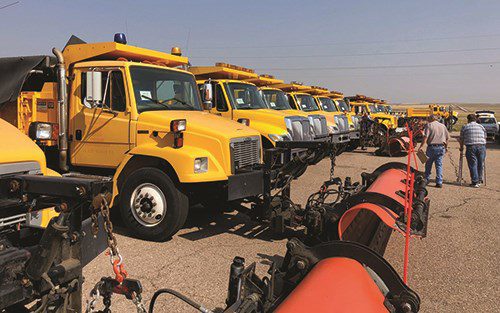Successful airports tend to operate at peak efficiency when they partner well with the state agency that supports them. This is especially true in Colorado, where the Colorado Department of Transportation (CDOT) Division of Aeronautics offers several programs to help member airports prosper.
Successful airports tend to operate at peak efficiency when they partner well with the state agency that supports them. This is especially true in Colorado, where the Colorado Department of Transportation (CDOT) Division of Aeronautics offers several programs to help member airports prosper.
Four programs, in particular, have been well received by airport operators and industry analysts alike:
- Airport Sustainability Toolkit
- Student Internship Program
- Annual Surplus Equipment Sale
- Remote Air Traffic Control Tower Program
Airport Sustainability Toolkit
This program was initiated by CDOT in 2015, in partnership with the FAA. It is designed to help airports maximize operational efficiencies in four core categories: social, environmental, financial and operational.
The toolkit is designed to help operators:
- increase competitiveness through lean operations;
- optimize the use of airport assets;
- reduce environmental impacts;
- work with and earn greater support from the community;
- improve employees’ work environment; and
- reduce health and safety risks.
|
Project: State-Sponsored Support Programs Location: Colorado Specific Initiatives: Subsidized student internships; Airport Sustainability Toolkit; annual surplus equipment sale with 50%-80% reimbursement for buyers; remote air traffic control tower test program Benefactors: General aviation & commercial airports Sponsoring Organization: Colorado Dept. of Transportation, Div. of Aeronautics Key Benefits: Programs help airport operators improve efficiency & boost profitability, reduce environmental impact, enhance safety/work conditions & improve community relations |
The pilot program was tested at three facilities: Centennial Airport, Rifle-Garfield County Regional Airport and Fremont County Airport. David Ulane, CDOT’s aeronautics director, reports that it has been very well received. “The toolkit is an online document available for free to any of our members,” Ulane specifies. “Airport managers can adapt the document to their particular needs. The basic idea is to help airport managers keep track of all of their operations.”
Although the program was initially designed for general aviation airports, larger airports are using it as well. “We recently worked with Colorado Springs Airport on the development of their toolkit, which is still in progress,” Ulane continues. “In addition, Rocky Mountain Metropolitan Airport also has implemented a sustainability plan using our toolkit.”
Other states are welcome to request the toolkit. “We use the Salesforce platform, so a given state’s software should be compatible with that to optimize its effectiveness,” he advises.
Internship Program
CDOT Aeronautics partners with several Colorado airports to provide educational internships that offer select students real-world experience with aviation and airport management.
Participating airports include Aspen/Pitkin County Airport, Centennial Airport, Colorado Springs Airport, Durango Airport, Eagle County Regional Airport, Greeley-Weld County Airport and Northern Colorado Regional Airport.
“Promoting aviation and education is part of our mission statement,” Ulane says. “A high percentage of our interns do end up working in our industry.”
CDOT provides grants to airports employing interns and pays 50% of students’ salaries, up to $20 an hour. Participating airports must cover the remaining costs. Individual internships vary in length from a semester to a full year. “This program, which has been going on for more than 20 years now, is a great way for airports to give college students exposure to the profession. In fact, five out of the eight people on our staff started as interns,” Ulane remarks.

Participating airports must supply a detailed syllabus, including a list of specific duties for interns. “We don’t just want them shoveling snow,” Ulane emphasizes.
Later, students can use the syllabus to show prospective employers exactly what they did during the internship, which enhances their chances of landing permanent jobs.
Each airport sets the agenda for its intern(s). “We don’t get into criteria,” says Ulane. “We do prefer the students take courses that eventually will help them get into the aerospace field.”
CDOT Aeronautics also offers its own internship, in which a student can work with the Division team to learn about state aviation agency operations. ”Our program is more government-oriented,” Ulane explains. “Students interested in a public-service career path can apply with us, and have great exposure to a variety of aviation stakeholders.”
Surplus Equipment Sale
This event is held once a year in August or September, and has occurred for at least 15 years. It started when CDOT agreed to help Denver International Airport (DEN) help sell its surplus snowplows, pickup trucks, lawn mowers and other airport equipment. This used but well-maintained equipment has reached the end of its life at DEN, but still has significant life left and value for a smaller airport.

The annual surplus equipment sale is especially popular with small airports.
The event is not an auction. Airports set prices for their equipment, and CDOT compiles a master list of items available for sale. The final cost for equipment is typically quite low, because CDOT reimburses airports for a hefty portion of the purchase prices. “We cover 80% of the first piece of equipment and 50% of the second and third piece,” Ulane specifies.
He offers the following transaction as a representative example: About two years ago, DEN listed one of its Oshkosh H-series 22-foot runway brooms, which cost about $500,000 new, for sale at $20,000. Since CDOT covered 80% of the asking price, the San Luis Valley Regional Airport in Alamosa was able to buy the machine for $4,000. “These smaller airports could never afford this machine on their own,” Ulane remarks.
The process starts in early summer, when DEN sends CDOT a list of machines it wants to sell. Then CDOT posts the list on its website and holds a “draft lottery” to determine the order that airports interested in buying may make their selection(s). Participation varies year-to-year based on equipment needs and availability, but about 16 airports usually make purchases.
The sale is held at DEN, and interested buyers can arrive a day early to preview available items. Last year, Colorado Springs Airport and Rocky Mountain Metropolitan also offered equipment for sale. Airports interested in their items made onsite inspections at the respective seller’s airfield.
Airports purchasing equipment must pay the full listed price at the annual event in DEN. They then receive reimbursement for the portion CDOT covers (either 80% or 50%) in about one week. “We just need a detailed invoice of the sale,” Ulane elaborates.
Remote Tower Project
This may be the state’s most ambitious effort to support its airports. Some industry watchers predict that the high-tech approach CDOT is testing for air traffic control could have long-term implications for airfields throughout the country.
Installing remote air traffic technology will eliminate the need for some airports to build, maintain and staff a physical control tower. “The concept is to avoid the cost of having to build a new air traffic control tower,” Ulane explains. “The FAA will not reimburse smaller airports for a new tower, which can cost an average of $12 or $13 million.”
The remote tower program is a follow-up to the Aeronautics Division’s previous partnership with FAA on the Colorado Mountain Radar Project. That project deployed wide area multilateration technology to Colorado’s high country to provide FAA air traffic controllers radar-like air traffic information without the need for costly radar installation. The Colorado Remote Tower Project features ground-based video technology, combined with an FAA radar data feed, to provide a comprehensive view of air traffic on the surface of an airport, and in the surrounding airspace.
The technology is currently being tested at Northern Colorado Regional Airport (FNL) in Loveland. It was chosen based on several factors, including air traffic mix, aircraft operational levels, proximity to a major airport and local support. “FNL is the busiest nontowered airport in the state,” says Ulane. “It has about 100,000 operations a year.”
In a unique funding about-face, CDOT provided the FAA with funding ($8.8 million) to perform testing for the program. The FAA is expected to bring a mobile air traffic control tower—essentially a small traditional control tower on a trailer—to FNL in January 2020. The airport’s traffic will be controlled from that tower, while other controllers monitor and “follow along” from the remote facility. This will help develop standard procedures, and allow adjustments and enhancements to the remote tower system.
The system is comprised of three camera tower installations. The primary one in the center stands 77 feet high, with 17 cameras that provide 360-degree coverage. The other two, positioned at opposite ends of the main runway, have 180-degree views, and are 22 feet tall. All three camera installations provide a high-resolution view of air traffic within the FNL airspace. They are heated and weatherproof, with wiper blades to clean the camera lenses.
The control room is on FNL property, located in a repurposed terminal building. “With this technology, the control room can be placed just about anywhere,” Ulane exclaims. “In Sweden, one is several hundred kilometers away. But the airport that uses this, Sundsvall Timra, only has five or six flights a day.”
Testing on remote tower technology will continue for the next two years, and is expected to be fully implemented at FNL sometime in 2022.
Broader Potential
Pam Keidel-Adams, a vice president with the consulting firm Kimley-Horn, says that Colorado’s airport programs could serve as excellent models for other state agencies. As part of the firm’s Aviation Leadership team, Keidel-Adams works with aviation agencies in several states.
“Colorado was the last state to have an Aeronautics Division, so that has given this particular agency a lot of flexibility, which I think helps them quite a bit,” she says. “Their charter is pretty broad, which encourages creativity. Many of their programs could be utilized in other states.
 “For example, their internship program has been very successful.
“For example, their internship program has been very successful.
“Many of the interns are now working in the industry. From pilots to airports to aviation consulting, there is such a huge need for great candidates, and this program is making a difference,” Keidel-Adams says.
In fact, Kimley-Horn recently hired an intern who was working at CDOT Aeronautics as part of the team working on the Colorado Aviation System Plan and Economic Impact Study.
She also gives high marks to the Sustainability Toolkit and surplus equipment sale for their impact on smaller airports.
Keidel-Adams is paying keen attention to the remote tower project. “If the testing goes well, this type of operation could really expand not only in North America but around the world. It will be fascinating to see how it all works out.”
After working with CDOT Aeronautics for several years on various projects, Keidel-Adams believes that the state’s airports are in good hands. “I think many of these projects have improved the overall economic health of Colorado’s airports.”


 facts&figures
facts&figures

